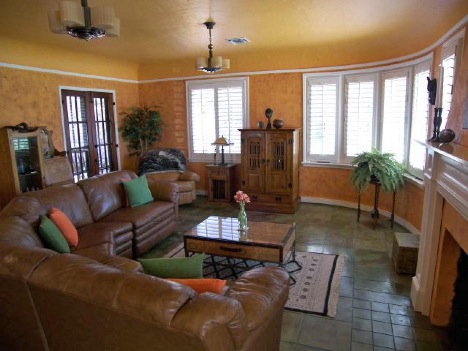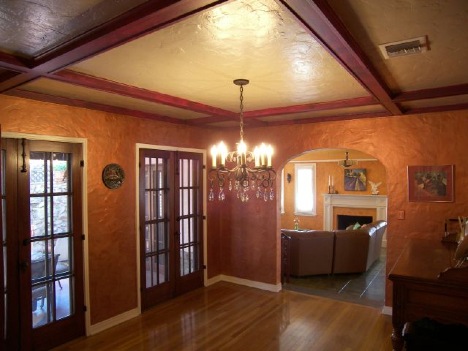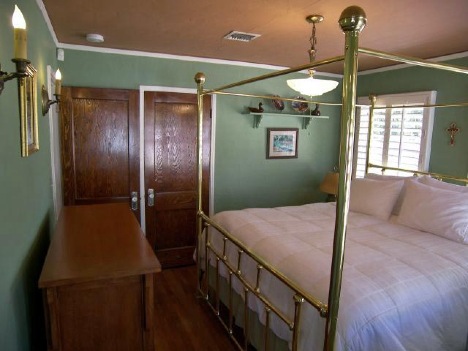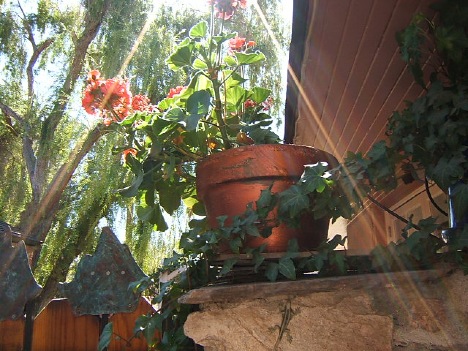Coming back to this, I wanted to spend a few minutes on photo composition techniques. That’s almost absurd: Who doesn’t know how to take a picture? Almost everybody, it turns out. We’re not talking about Ansel Adams levels of perfection, we’re talking about taking real estate photos that sell the property but don’t require a lot of back-end effort on your part. That means that we want to take a photo we’re ready to show off as-is, not one that requires cropping or re-touching in PhotoShop.
Here’s an obvious rule first: A camera is not a gun, and a house is not its target. If you look at published real estate photos, again and again you’ll see the house centered in the frame with miles and miles of do-nothing sky above it. This is wrong. Fill the frame with whatever it is you’re drawing attention to. If you think you might want to crop the image later, why not crop it now by filling the whole frame?

We like drama, so often we’ll get in really close at a point of view much lower than normal (it’s called crouching or kneeling; even old people can do it). In this case we also blasted hard with an electronic flash — even in bright sunlight outdoors — in order to bring out the details that would otherwise be in shadow.

Another way to lend drama to a scene is to go higher than eye-level and look down. Most digital cameras have a video viewfinder, so it’s easy to frame photos while holding the camera overhead.

If the ceiling is interesting, it should be in the photos. The wide angle lens on your camera will include the floor and ceiling of your interior shots, so you should be watching for things to bring out. Here in Arizona, ceiling fans are worth money, so we make sure we show them off.

Here is the value of a very wide angle lens: We can see this whole bedroom in two photographs. The human eye is much more adept at apprehending visual information than any camera. Our eyes-forward range of vision is huge, our peripheral vision is even more immense, and our eyes are darting around all the time, pulling in absolutely everything. Photography is a crude approximation of vision, but the closer you can emulate human sight, the more satisfying the experience.

We sell homes, not houses. We devote dozens, sometimes hundreds, of photos to the little things that make a house a home. It’s not too wide of the mark to say that women buy houses, men buy garages (there’s the title of my real estate book!), but every potential buyer should be able to see every detail that might be important to that buyer in your photographs.
Which implies the ultimate best rule I know of for real estate photography: Take a lot of photos. You might need to throw away a huge portion of those you take, but you will bring great added value by marketing your home with a lot of photos. It argues that you care about what you’re doing, a subtle marketing message. It effects the passive salesmanship of the home — and that may be all the salesmanship you will be able to exert. And a great quantity of photos can cause potential buyers to commit to the home you are selling simply because they have committed so much time to looking at it. At a minimum, the more time they spend looking at your house, the less time they have available for others.
Doing real estate photography this way takes time, and that’s why you want to maximize your effort by taking exactly the pictures you want. But no matter how much time I might have spent inside a home, invariably someone will point out something in a photo that I had not seen. That’s how carefully your prospects are looking at your photos, and that’s why making this effort pays off so well.
Technorati Tags: arizona, arizona real estate, phoenix, phoenix real estate, real estate, real estate marketing
Michael Price says:
GS, Excellent post and great photos. As I commented in the RCG photo post a while back, anyone using a wide angle lens should install the PTLens plug-in for photoshop or photoshop elements and run the photos through it before doing anything else with them. Pincushion and barrel distortion are notorious in wide angle photos and this free tool is indispensable. Get it at http://epaperpress.com/ptlens/ My wife Laurie takes real estate photos every day and is always willing to answer a question or two about flash, composition and digital techniques if she isn’t busy at the time. She can be reached at laurie@sitetraffic.com
August 4, 2006 — 5:13 pm
Greg Swann says:
Excellent! Thank you.
August 4, 2006 — 6:44 pm
Michael Price says:
Heres a great article on high dynamic range.
http://news.com.com/Was+it+done+with+a+lens%2C+or+a+brush/2100-1041_3-6101885.html?tag=nefd.lede
August 6, 2006 — 7:49 am
CHCollins says:
The only thing I’d like to point out is that culling takes time. Digital shots are “free”, yes, but taking too many of them then has you spending time picking out the best ones for your client to approve, filling up your hard drive, etc… that’s the trap I initially fell into. My advice, for your personal productivity, is to limit yourself to a couple of good compositions per scene at capture-time, and use your “free” digital shots for bracketing purposes (assuming you have exposure control).
October 2, 2006 — 12:58 pm
Greg Swann says:
> The only thing I’d like to point out is that culling takes time.
Excellent advice. Thanks!
October 2, 2006 — 8:02 pm
Sharon Simms says:
I’ve always believed in LOTS of photos. You’ve given some excellent ideas in your post. Storage can be a problem, so we burn all the photos of a property onto CDs. We keep one, and also provide a CD for both seller and buyer.
Even an unselected photo can be useful – proving which refrigerator or light fixture was in place at the time of contract, etc.
December 2, 2006 — 7:57 am
Carson Coots - Real Estate Photographer says:
I love the idea of taking the detail shots … like the planter photo. It really adds a dynamic when someone is browsing through photos on the fly. Is the lens-flair a perk? I think so. One thing I would like to add is about lighting. Try taking the photos at early dawn or late dusk with the white balance set on tungsten with no flash. You will see the drama unfold with those deep blue windows… but you need a tripod.
July 26, 2007 — 7:58 am
Robert Foote says:
Having taken thousands of real estate photos as a location scout in the film biz, the 24mm lens is just about right. The tripod is absolutely necessary and dont be afraid to use longer exposure times like 1/15th or 1/8th of a second to fill the scene the way the eye would. Great blog.
August 7, 2007 — 12:17 am
Sue says:
I see this is an old post and just have to say I love those pictures, the dramatic ones capturing the ceiling and several rooms in the home and the flowers with the rays of sunlight. Look very professional.
I’m just poking around cause I’m getting ready to buy a camera and doing some research, the pics were a treat!
August 23, 2008 — 7:17 pm